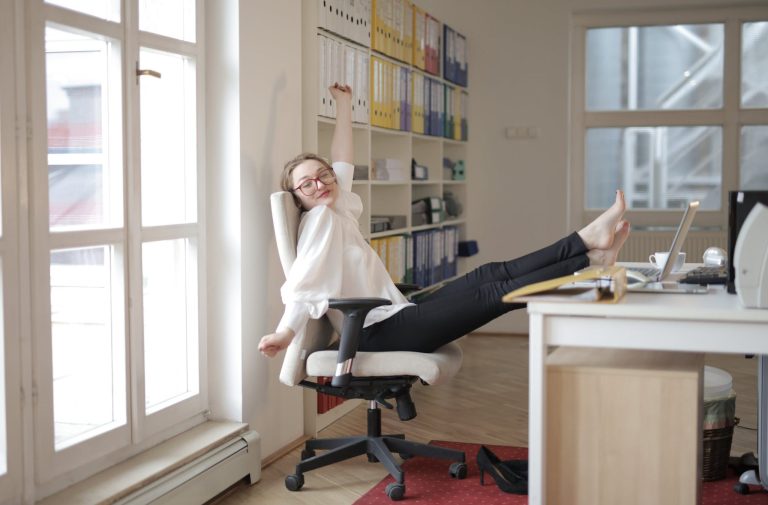
[ad_1]
Modern work environments can often mean hours at a desk, hunched over a computer. The result? Aches, pains, and poor posture. The good news is, you don’t need an expensive gym membership or a lot of space to counteract these negative effects. Enter office Pilates.
This form of exercise not only enhances posture and core strength but also alleviates back pain, making it perfect for those confined to an office setting.
In this blog post, we’ll explore some easy Pilates exercises you can seamlessly integrate into your workday. And don’t worry; no leotards are required!
1. Chair Roll-Downs
- Purpose: This exercise stretches the spine, allowing it to lengthen and relax. It also integrates a light bicep and shoulder workout.
- How to do it: Sit at the edge of your chair with your feet hip-width apart. Place your hands on the sides of your thighs. Inhale deeply, and as you exhale, begin to tuck your chin to your chest, rolling down one vertebra at a time. Let your arms hang in front of you, feeling a stretch in your biceps and shoulders. Go as far down as it feels comfortable. Inhale at the bottom, then exhale and slowly roll back up, stacking each vertebra.
2. Seated Spine Twist
- Purpose: This exercise helps to increase spinal rotation, working the obliques and improving posture.
- How to do it: Sit tall on your chair with your feet flat on the ground. Extend your arms out to the sides at shoulder height. Inhale deeply, and as you exhale, rotate your torso to the right, reaching your left hand towards your right foot. Inhale to return to center, then exhale and repeat on the other side.
3. Desk Plank
- Purpose: Strengthen the core and shoulders without needing to get on the floor.
- How to do it: Stand about an arm’s length away from your desk. Place your hands on the edge of the desk slightly wider than shoulder-width apart. Step back until your body forms a diagonal line from head to heels. Engage your core and hold this position, ensuring your hips don’t sag. Hold for 20-30 seconds, working up to a minute over time.
4. Pilates Leg Lifts
- Purpose: This exercise strengthens the hip flexors and quadriceps, essential for maintaining an upright posture.
- How to do it: Sit at the edge of your chair with your spine straight. Hold onto the sides of the chair for support. With a flexed foot, lift your right leg to hip height. Pulse the leg up and down for 10 repetitions. Switch legs.
5. Back Extension
- Purpose: Counteract the hunching that often comes with desk work, by strengthening the muscles in the upper and middle back.
- How to do it: Sit on the edge of your chair. Clasp your hands behind your head, keeping the elbows wide. Inhale deeply, and as you exhale, gently arch your back by looking slightly upwards and pressing the chest forward. Inhale to return to a neutral position.
6. Seated Saw
- Purpose: This exercise stretches the spine and provides a deep stretch for the hamstrings and IT band.
- How to do it: Sit tall on your chair, legs wide apart. Extend your arms out to the sides at shoulder height. As you exhale, rotate your torso to the right, and reach your left hand towards your right foot. Imagine you’re “sawing off” your little toe. Inhale to return to the center and repeat on the other side.
Conclusion
With the prevalence of desk jobs and prolonged sitting, the importance of office-based exercises cannot be overstated.
Pilates offers an accessible and effective way to combat the challenges of the modern office, focusing on core strength and flexibility to promote good posture and reduce back pain. Remember, consistency is key.
By incorporating these Pilates exercises into your daily routine, not only will you notice improvements in your posture and a reduction in back pain, but you’ll also feel more energized and productive.
So, the next time you feel that afternoon slump or tension in your back, take a few minutes for some Pilates – your body will thank you!
[ad_2]
Source link